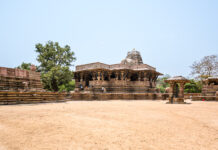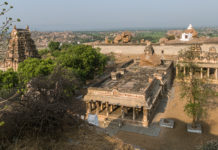Temple of Isis at Philae, Egypt
We did our Nile cruise with the river’s flow. From Aswan to Luxor. And before our cruise set sail, the cruise operator sent us off to a nearby attraction, the Temple of Isis at Philae. The boat ride to Philae lasted all of 15 minutes. Throughout the ride, we saw an intriguing structure that seemed to have popped out of the river. You cannot figure out the role of the massive stone pylons you see dominating the horizon. And prior to any more details, let’s just get going with some background.

Philae in Greek means ‘the end’. Built at the ancient southern boundary of Egypt, the Temple of Isis almost faced the end by getting submerged in Lake Nasser when they built Aswan Dam. It was UNESCO and the Egyptian government’s intervention that helped move the temple stone by stone, 50,000 of them, to a higher location on Agilkia Island.

The temples of Philae belong to the Greco-Roman period (332 BCE – 642 CE). This was the period when Egypt was first ruled from Rome, and later from Constantinople. Egyptian culture interacted with the Greco-Roman and Byzantine cultures and evolved into the form known as Coptic. Despite being occupied by Alexander’s army, Egypt’s language, religion, art, and culture prospered.
Construction of the Temple of Isis at Philae
Alexander’s general, Ptolemy II, built this temple circa 280 BCE as he founded the Ptolemaic Dynasty. Dedicated to Isis, Osiris, and Horus, they carved the temple walls with scenes from Egyptian mythology. These three characters dominate the Egyptian culture, and their story is no less than any Shakespearean tragedy.
Isis is associated with funeral rites, but also as the giver of life, a healer, and a protector of kings. Little wonder they represent her with a throne on her head. During the Roman period, her cult spread far and wide. There is even a temple dedicated to her in London.

Inside the Temple
Egyptian temples grew from small shrines in 3rd-4th Millennia BCE to grand structures in 1st Millenium BCE. Seeing Philae, I realised it belonged to the grand structures era. Two giant colonnades meant for festival processions flank its entrance. At the end of these colonnades, there is a pair of pylons 150 feet wide and 60 feet high. We know these as the Gate of Ptolemy. A small doorway in the left pylon leads to the birth house of Horus.

These pylons bear remarkable stone carvings and bas reliefs from Egyptian mythology depicting Pharaohs being led forward by Isis. Two Roman-style lion statues stand guard in front of these pylons. There were two obelisks here. But they have shipped them to Dorset. Those obelisks helped to decipher Hieroglyphs.

A smaller set of pylons lie beyond the sanctum sanctorum. Smaller is only relative. These pylons are 105 feet wide and 40 feet high. Interestingly, these are not parallel to the first set of pylons. Given the Greco-Roman influence, people have carved many Greek Orthodox church crosses across the entire complex. There is also a hypostyle hall with 10 massive pillars.

What next?
The Philae Temple complex has a few smaller shrines dedicated to other gods from Egyptian mythology. UNESCO inscribed it along with the Temples of Ramses II at Abu Simbel on its World Heritage List in 1979. For a religion no one practices anywhere anymore, Philae Temple evokes awe for its structure and layout. This architectural feat, though remarkable, is not unique, as I’ll share with you in posts that follow. Entire Egypt has a larger-than-life presence of such mind-blowing prehistoric temples and monuments. Wait for more next week.





















